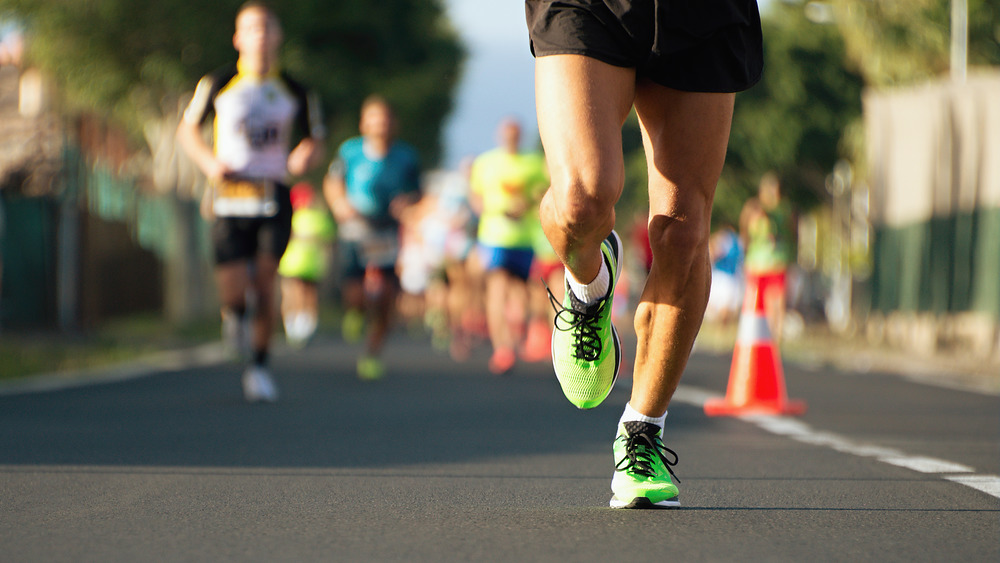How Running A 5K Every Day Really Changes Your Body
Running a 5K (aka 3.1 miles) is a big undertaking, especially if you're new to running or you're getting back into exercise after taking a break. As such, you can expect to see some pretty significant changes in your body (not just physically, but mentally and emotionally, too) when you start trotting those k's on the regular. But it's important to remember that exercise is a form of self-inflicted stress. Yes, it's good-for-you stress, but too much stress placed on your body, too fast, too long, or with too much intensity can lead to some less-than-desirable results.
While many people, can, in fact, knock out three miles a day without ending up hurt or sick, it's important to listen to your body and make adjustments to your route, pace, and intensity as necessary. A regular running program can do wonders for your all-around health, but only if you're doing it wisely.
A daily 5K will lead to better cardiovascular health
Cardiovascular health is all about strengthening your heart, increasing lung capacity, and improving the delivery of oxygen-rich blood throughout your body. Having a strong cardiovascular system is pretty important for, you know, living. And, naturally, running is an excellent form of cardiovascular exercise. When performed regularly, running practically guarantees improvements to your cardiovascular system.
A 2014 study published in the Journal of the American College of Cardiology found a 45 percent decrease in mortality from heart disease. As the study's author, D.C. Lee, an assistant professor of kinesiology at Iowa State University, told Time, "Runners on average lived three years longer compared to non-runners." This was independent of how fast, how long, or how often the runners ran. In a follow-up study by Lee and his colleagues, running two hours a week was associated with an additional three years of life, the magazine reported. Whether you run at breakneck speed or a snail's pace, you can rack up those two hours a week and boost your longevity.
You can expect increased muscular endurance following your everyday 5Ks
You may not realize this, but there are two forms of muscular fitness: muscular strength and muscular endurance. The difference between the two basically hinges on what actions you're asking your muscles to perform. When you run every day, you're telling the muscles of your lower body, core, and even your chest, shoulders, and back, to perform repetitive, ongoing actions for a sustained period of time.
As Healthline pointed out, you're basically improving the stamina of your working muscles. To continue to lift your feet, swing your arms, and carry the weight of your body forward, your muscles have to adapt to the action and become more efficient and more capable of sustaining this sub-maximal effort for a prolonged period of time.
When you first start your 5K-a-day program, the muscles of your legs may fatigue quickly, forcing you to slow your pace or switch to walking. But with continued practice, you'll notice the muscular fatigue taking longer to build, enabling you to run farther at a given pace. This is muscular endurance in action.
Running a 5K every day can increase your muscular strength
Running isn't just a boon for muscular endurance, it can also boost muscular strength. This is particularly true at the start of a new program when your muscles — especially the large muscles of the lower body, like the quadriceps, hamstrings, calves, and glutes — need to develop greater strength to be able to physically lift and move the weight of your body over the course of a run.
A 2014 study published in the Exercise Sports Science Review confirmed that aerobic exercises, like running, can in fact improve muscular strength and size (also known as hypertrophy) in addition to muscular endurance. That said, if you fail to keep challenging your muscles with new stimulus, like adding sprint work hills to your training program, there's going to be an upper limit on how much strength and size you develop.
As a 2019 review of studies published in Sports Medicine confirmed, you will need to add strength training to your routine if one of your fitness goals is to see substantial muscle growth.
Improved joint strength will follow your daily 5Ks
Repetitive aerobic exercise like running isn't just good for your muscles, it's good for your joints, too. Just as muscles adapt and adjust to new stressors and stimuli, your joints — including connective tissue like tendons and ligaments — do, too. And what might surprise you is that runners might actually end up with fewer instances of osteoarthritis than those who participate in lower-impact activities like walking.
According to a longterm study published in Medicine and Science in Sports and Exercise, more non-runners reported experiencing osteoarthritis than runners. This may be due to underlying health issues or possibly runners having lower overall body weight, which reduces wear and tear on the joints, but it's an interesting finding regardless.
Exercise physiologist Biara Webster explained to Livestrong that starting slowly with your new habit is key to avoiding injuries. "I would advise running every second day, alternating your program with strength training, especially of the core and legs if running is your goal," she said.
You could be at risk of overuse injuries when running a 5K every day
One thing to keep in mind about running is that it's a high-intensity, high-impact exercise. While there's nothing inherently dangerous about it, and many people's bodies can absorb a daily running routine without injury or problems, it's very important to ease your way in to the exercise and remain conscious of how your body's reacting and responding to the stressor. This is because, as Healthline pointed out, a daily running routine can increase the likelihood of an overuse injury, like a sprain, strain, or inflammation of the muscles, tendons, or joints.
Overuse injuries usually happen when you take on a new routine and do too much, too fast, and too soon. That's why you may want to start your daily running routine as a run/walk combination, running one day and walking the next, or you may want to keep your runs short and at a lower-intensity at least a few days a week, according to Healthline. And it's important when your body's feeling achy or under the weather to be especially conscious of your form, or simply take a day off. You don't actually have to run a 5K every single day!
You might lose weight if you run a 5K every day
If you're looking to lose weight, you may be considering implementing a running routine. The good news is, if that's your goal, it's entirely possible. If you incorporate interval training or higher-intensity sessions into your daily running routine, you'll end up burning a significant number of calories during and after your workout, which helps boost your metabolism all day long, according to Healthline. There's also evidence that a high-intensity running routine helps suppress appetite, which might make it easier to balance your calories in/calories out to create the calorie deficit needed to experience weight loss.
That said, weight loss isn't a guarantee, which is why you need to pay attention to your eating and exercise habits if weight loss is your goal. While you might experience a suppression in appetite, you might not. In fact, try not to view your running routine as an excuse to chow down at every meal. You still have to make sure you're consuming fewer calories than you're burning throughout the day if you want to drop a few pounds.
You might lose a few toenails if you commit to running a 5K every day
Running is, uh, not always pretty. If you're hitting the roads on a daily basis, really racking up those miles, your feet are likely to start looking a little ragged. To be fair, you're putting a lot of stress on those dogs, so it shouldn't come as a huge surprise. That said, if you notice your toenails turning black and blue, it might just be a matter of time before one or two of them falls right off.
In an interview with Everyday Health, Kevin Burns, a fitness instructor and spokesperson for the American Council on Exercise, explained that this is usually due to ill-fitting running shoes. "The correct shoe can make all the difference," Burns told the publication. Too-small shoes can actually cause your toes to jam or rub against the front, leading to bleeding under the nail bed.
While it can be tempting to start your running routine by lacing up the old sneaks you've had sitting in the back of your closet for a couple years, your best bet is to buy a new pair of kicks after an actual fitting at a store that specializes in running.
Running a daily 5K can lead to some serious chafing
If you've ever experienced chafing between your legs, you know it's uncomfortable. And unfortunately, running can often lead to chafing. This is because you're combining the friction between your running shorts or underwear and thighs with sweat, which often ends up delivering the tell-tale burning rash.
The good news is you can try to reduce the likelihood that chafing will happen by choosing the right running gear. As Everyday Health advised, choosing garments with moisture-wicking properties and those that promise to reduce rubbing can help. For instance, opt for running shorts or tights made of nylon or spandex rather than cotton (which can stick and pull, especially when wet). Also consider using products like Vaseline or chafing cream to reduce friction at any trouble-spots.
Running a 5K every day will help you increase your speed
If the first time you trot outside for your 5K, you log a 15-minute mile, you can feel confident that you'll see an improvement in your speed over time. This is true even if you never had the desire to run at a breakneck pace. It all boils back down to the concept of efficiency and adaptation. Because your body doesn't like doing things inefficiently, the adaptations it makes to improve efficiency, such as better cardiovascular circulation and lung capacity and improved muscular endurance and strength, will inevitably make that 15-minute mile feel easier over time. And as it feels easier, you're likely to pick up your pace, even if just by a little bit.
As an example detailed on Men's Health, personal trainer Alex Crockford implemented a daily 5K into his routine to see how it would affect his body. After just 10 days, he noticed an improvement in his running times, reducing his 29-minute 5K to a 25-minute run. By the end of his 30-day trial, he got his time down to 23 minutes. The thing is, getting faster wasn't his goal — it was a natural byproduct of the process.
Running a 5K every day can stave off chronic disease
Running does your body good. It's not just your physical performance and cardiovascular health that benefits, either. Running can pay off big time when it comes to reducing the risk of a multitude of chronic diseases. According to Healthline, running just five to ten minutes a day at a moderate pace (roughly a ten-minute mile) reduces the risk of cardiovascular disease, heart attack, stroke, cancer, Alzheimers, and Parkinson's. One study found even found that running can reduce the risk of death from all causes by as much as 30 percent.
Dr. Michael Chan, an interventional cardiologist with St. Joseph Hospital in Orange, California told Healthline, "Exercise has been shown to reduce many of the factors that lead to heart disease so it reduces diabetes, it reduces hypertension." The all-around health benefits of a regular running routine are clear: A little bit of running, done consistently, may help you lead a longer life with fewer problems related to chronic illnesses.
Running a daily 5K can improve your mental health
Running can improve your mood and give your mental health a boost, Johns Hopkins Medicine confirmed. These benefits take place during and following each run. First, your body releases "feel good" hormones called endorphins while you're running. These can help prevent the working muscles from feeling pain, enabling runners to keep pushing. And, in some cases, may contribute to the "runner's high." Second, after a run, the body releases endocannabinoids, a substance that's a little like cannabis but produced by the body. These help give you a relaxed feeling post-exercise, and they can also help ease anxiety.
Ultimately, these changes can improve your mental health. "Exercise has a dramatic antidepressive effect. It blunts the brain's response to physical and emotional stress," David Linden, a professor of neuroscience at the Johns Hopkins University School of Medicine, explained. For those who run regularly, mental health benefits can include improved memory, elevated mood, and better task-switching performance.
You'll likely sleep better following your everyday 5K
Believe it or not, a daily running routine can even improve your sleep. In a 2010 study published in Sleep Medicine, individuals who reported sleeping fewer than 6.5 hours before implementing a six-week workout program saw an increase in nightly sleep time of 75 minutes — better results than typically seen even with sleep medications.
As W. Christopher Winter, the president of Charlottesville Neurology and Sleep Medicine, told to Everyday Health, "Physical activity creates more adenosine in the brain, and adenosine makes us feel sleepy. The harder we work out, the more driven we are by this chemical to sleep."
As such, running on the regular can help your body naturally start to slow down and ready itself for sleep as day turns to night, improving or maintaining your natural circadian rhythm. And the good news is it doesn't really matter what time of day you squeeze in your run. Winter suggests figuring out what running schedule works for you, because running at night might keep one person awake, while another person can easily hit the sack.
Running a 5K daily can increase your productivity at work
If you're looking to impress your boss by beating every deadline and maximizing your workday performance, your daily 5K might just do the trick. According to a 2008 study published in the International Journal of Workplace Health Management, volunteers self-reported their mood and productivity on days that they exercised and days they didn't exercise. It was found that the workers had a better overall mood and workplace performance on the days they exercised. These reports were independent of the type of exercise performed or how long or intense their bouts of exercise were.
The study also noted that the improvement in performance at work appeared to be linked directly to the improvement in mood. In other words, when someone felt happier or more "up" at work, they appeared to be able to focus and perform better. That makes sense; when you feel good, your interactions with others and your approach to everyday stressors and tasks feel easier to navigate. Who knows? Maybe after a couple months of better workplace performance, your boss will even consider that raise you've been itching for.
Running a 5K every day might improve your love life
Okay, so if you start your running routine with the goal of improving your physical appearance, you may hope that the habit will translate to a more active love life, too. Interestingly, research indicates that those who run on the regular can, in fact, experience benefits in their love lives.
As Women's Running highlighted, there have been several studies that have linked exercise to an increase in libido. Dr. Marilyn Glenville, a psychologist, told the publication that this benefit is linked to exercise's mood-boosting powers as well as its ability to reduce feelings of stress, improve confidence, and enhance overall body image. Stress, fatigue, and self-consciousness are all major factors that inhibit libido and may lead to less action between the sheets. And because running can enhance all aspects of mental health while also boosting body confidence, it's a big help when it comes to getting busy.















